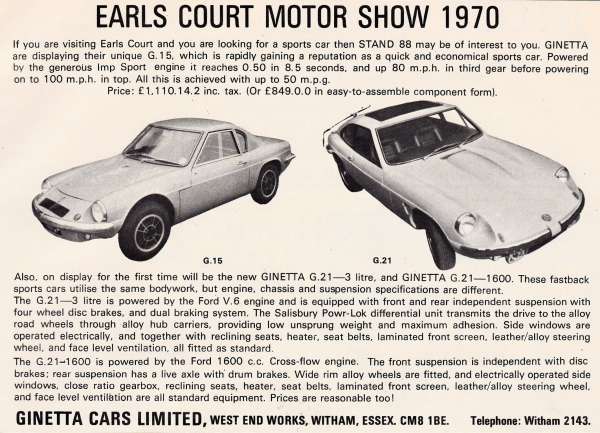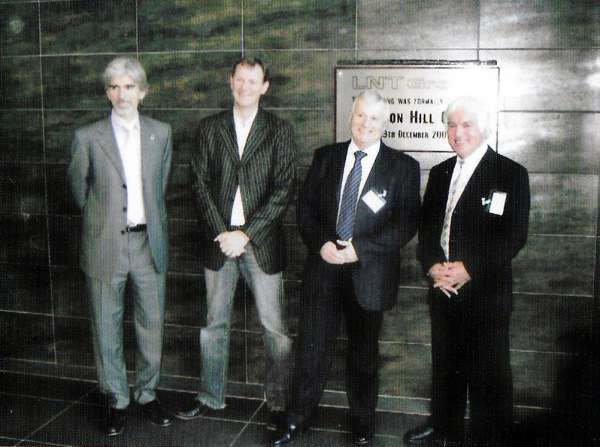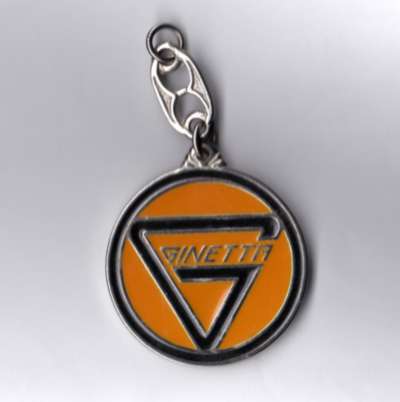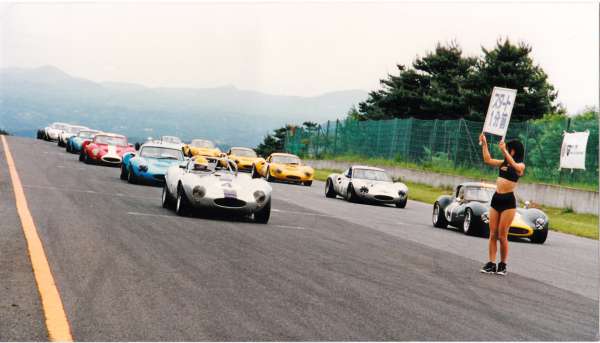| IVOR WALKLETT - PART 2
Researched & compiled by Geoff Gonella
Peldon History Project
Part 1 covered much of Ivor's working life as car designer and co-Director of Ginetta Cars Ltd. in the world of motor racing and British car manufacture. But things were about to change, many times. Here is the concluding part of his fascinating story.
The G21
While the G15 was being produced in large numbers until 1974, the Brothers were developing their next car, the G21. It had fastback styling, much interior space, and high-level equipment for its day (reclining seats, heater(!), seat belts, laminated front screen, leather/alloy steering wheel and face-level ventilation, all as standard). (1)(2)

Magazine advert promoting the G15 and G21 at the Earls Court Motor Show
Initially it was available with a choice of two engines, a 3 litre Ford V-6 or a 1725cc Sunbeam Rapier engine (which became the standard one). There was an 'S' version of this car, which used a Holbay engine for increased power. (1)
It was first shown at the 1970 Earls Court Motor Show, and by 1973 it had passed European type approval, so it went into production alongside the G15. (1)(2)(4)
Return to Witham
Sales of the G21 were disappointing, and along came the 1973 fuel crisis and subsequent financial squeeze. These economic conditions hit most of the small-car manufacturers, with names like Aston Martin and Jensen going into Receivership. Ginetta needed to scale down considerably, so in 1974 it moved back to the Witham premises, which the Brothers had shrewdly retained when moving to Sudbury. (3)(5)
Once back at Witham Ginetta had settled all its committments and was still trading. Sales of the G21 were still low, so they had a period on consolidation by selling cars direct to the end-user, refurbishing older Ginetta models, tightening belts and keeping out of debt. Production of the G15 ended that year, but the G21 would continue until 1978 with a total of around 150 built. (1)(4)

G21 brochure - 1

G21 brochure - 2
In later years Ivor recalled that situation in an interview with 'Octane' magazine:
"......While there had been previous attempts at road cars, the pretty G15 was the first to sell in volume. Launched at the 1967 Earls Court Motor Show, this Imp-engined sports car became an instant hit; hence the move to a new, larger factory in Sudbury.
We couldn't make them fast enough. Ginetta fully Type Approved it. We also introduced the G21, but then along came the oil crisis, the imposition of VAT and the 3-day week. It was an awful time, what with all the strikes and so on. We had fully Type Approved it, as we did with the G15, and with the 1725cc four-cylinder Sunbeam engine the G21 was a lovely car. But we were up against the MGB GT at a time when British Leyland was being subsidised by the Government, so we never stood a chance. Fortunately, we hadn't sold our old place in Witham, so we moved back in.
It wasn't a great time for Ginetta, and I don't have particularly fond memories of that period. The G15 continued to sell for a while because the price was right and, while we hadn't conceived it with racing in mind, Barry Wood was very successful in our works car. The problem was, we started to lose orders for the G21 due to the economic climate. Then we received a letter from Chrysler saying that it was about to stop production of the Imp!
They behaved honourably, and offered us an all-time requirement deal whereby they would build and store engines for us,but that meant that we would have to make quite a large investment. We investigated some alternatives but they didn't come to anything. We also did a small batch of VW-engined cars for our US importer. Ginetta survived the 1970s by building the occasional car and selling spares......" (5)
One highlight in the 1970s was that more enquiries started to come in for G4s and G15s. These models were racing well on various circuits, including a race at Brands Hatch where, to the huge amusement and delight of the spectators, a Ginetta G15 fought it out with a 5.3 litre E-Type Jaguar. For five laps the 'David and Goliath' battle raged until the E-Type spun-off, in its vain attempt to match the phenominal cornering power of the tiny G15. (4)
Home and family
In 1977 Ivor and wife Viv moved to Ransomes Cottage, Peldon, and have stayed there ever since, bringing up three children there. When their first was born, this appeared in the Peldon & Wigborough 'Parish News':
SPECIAL 1979 MODEL
Ivor Walklett is quite used to dealing with car specyyifications. When he and Vivian welcomed a baby to the family, he drew up a unique specification for her:
| New model | February 1979 |
| Manufacturer | Vivian / Ivor |
| Weight | 7lb 4oz |
| Length | 20 inches |
| Styling | Streamlined aerodynamic body. Pretty exterior. |
| Chassis | Semi-rigid backbone |
| Suspension | Independent all round |
| Fuel - Inlet | Through small hole at front |
| Fuel - Outlet | Through small vent at rear |
| Lubrication | Grease points at rear |
| Exhaust | Single down-pipe |
| Wind noise | Moderate |
| Seat covers | Changeable |
| Warning system | Built-in alarm system |
I guess she looks good under her bonnet too!
The G4 Series 4
In 1979 Ginetta was considering the direction it should take, in what were difficult times for the motor industry. Development of the G23 and G24 models (open-top and hard top descendants of the G21) was underway, but the market for these was looking less certain. This, together with two other factors, began to influence the Brothers' thinking. The first factor was news that production of the MG Midget and MGB would cease, followed closely by the Triumph Spitfire and TR7. This would leave a large gap in the market for small, reasonably priced open-top sports cars. The second factor was that there were frequent customer requests to supply brand-new G4's, because the originals had become highly sought after. (2)
The Brothers concluded there was still a demand for this type of sports car, and debated whether to re-introduce the G4. By mid-1980 they decided not to go into production with the G23 and G24 models, but to have a revival of of the G4, changed to meet the needs of the sports car driver of the day, plus some updating and design improvements to aid manufacturing. The result was the G4 Series 4 Kit Car, launched in 1981. It was produced through to 1984 with approximately 35 built. (2)
The G25
Ginetta needed a replacement for the G15, and the G25 was conceived. It was the first British mid-engined road car. As a two-seater with many Ford parts, it marked the beginning of a new line of models in 1983. However, Ginetta would need to design the rear suspension, and with an increasing demand for 4-seaters, the Brothers eventually decided on a 4-seater, designated the G26. So work on the G25 was stopped even though it was near to completion, but it was later developed into the G32 for production and Type Approval. (1)(3)(4)(6)
The boom in Component Cars
Ginetta then made various models of Component Cars, the G27, G26, G28, G30 and G31, all with Ford parts.
Note. A Component Car is a full set of parts sold by one company for the customer to assemble a complete car. (4)
The G27 was a refined design of the G4 Series 4, with a Ford Pinto engine. (Note. a G27R model was produced in the 1990s for a one-make race series).

Mark Walklett's G27 race car
The G26 was a 4/5-seater with a low front and pop-up headlamps, using styling from the G25.
Note. At this time Ivor was interviewed by a car magazine about the design philosophy for the G26. The resulting article was called 'Walklett Talk', and is shown below. Although it seems rarther dated now, it gives an insight into various aspects in design of these cars.

Article 'Walklett Talk' regarding the G26 design philosophy
The G28 needed to accommodate a larger V-6 engine, so Ivor designed a higher bonnet line, with styling from the G25 but with fixed headlamps. The G30 and G31 were front and rear body combinations sourced from the G26 and G28. (1)(3)(4)

G31 sales leaflet
The G32 and G33
The Brothers also decided to have two fully built models, the mid-engined G32 as a coupé or convertible, and the G33 as a convertible.

Ivor's outline drawing for the G32 concept

G32 sales leaflet

G32 technical specification
The G32 was conceived from the G25, but as a mid-engined two-seater powered by a 1.6 or 1.9 litre engine. It was intended to rival to the Toyota MR2 and have European Type Approval, which it achieved after passing 26 tests (and crash tests) over 12 months at a cost of £100,000. (1)(3)(4)
Change of ownership
In 1988 the Brothers moved the company to Scunthorpe Lincolnshire, to manufacture the G32. After being there for about 18 months, news broke that the Brothers had sold the company to a consortium led by Sheffield businessman Martin Phaff. This must have come as a complete surprise to many, after 31 years of continual Walklett ownership and direction at every level. And it must have been a wrench for each of the Brothers, for whom Ginetta was a way of life. Their agreement to sell was principally to ensure that the name Ginetta would continue under sound management, and to provide for a well-earnt retirement for the Walkletts.
Directly after the sale, Douglas, Trevor and Bob each took retirement, and Ivor remained as Technical Director, responsible for new car designs and other technical matters, thus ensuring Ivor's continued flair and influence in car design and development. (2)(4)
The G33
In 1990 the idea for the G33 was sketched on a tablecloth in a Pizza restaurant by Mark Walklett (Trevor's son, a highly experienced racer) and Noel Palmer (who had worked for TVR). It seemed like a great idea, and the tablecloth was taken away at the end of the evening as a 'blueprint'.
Although the G32 was the main car taking up the resources of the Ginetta company under the Martin Phaff consortium, the G33 was more of a supercar experiment. It used the tried-and-tested G27 body shell, but enlarged to accommodate a front-mounted Rover 3.9 litre V-8 engine, driving the rear wheels. Performance was to be 0-60 mph in 5 seconds and maximum speed 150 mph.

G33 sales card
A prototype was shown at the 1990 Motor Show and subsequently road tested by Tiff Needell for the 'Top Gear' programme. It was also featured on the cover of 'Autocar', 'Performance Car' and 'Which Kit?'. Enquiries flooded in, and this marked Ginetta's return to high performance, lightweight sports cars for road and track use. With a trace of previous models in the overall rounded, aggressive styling, the G33 was an all new, two-seater convertible with a body in GRP. The Interior had leather seats, deep pile carpet and traditional instrumentation directly in front of the driver.
It was sold as a fully-built car except for the customer needing to to complete a specific, but uncomplicated job, then submitting the completely finished car for an MoT test in order to get it registered (this has since been superseded by the need to pass a 'Single Vehicle Approval Test').
Road tests were favourable for this road racer. Other cars of similar layout and performance were the TVR Griffith, The Morgan V8, The MGB V-8 and the Westfield Seight.
It was an agile performance car that could be used for longer distances than some of the 'track only' cars. It sold well, through a new series of dealers in the UK and abroad, thanks to its good looks, fantastic exhaust note, and performance. A number were exported to the Japanese, who just love British sports cars. (3)(1)
In 1992 Douglas Walklett sadly died in retirement.
Change of ownership again
In September 1992 Ginetta, under the Martin Phaff consortium, went into liquidation. Ivor had left by then. (1)
DARE UK Ltd.
In 1990 Ivor and brother Trevor had founded DARE UK as a design consultancy ('Design And Research Engineering'). It acquired a major interest in the Rights to the Ginetta G4 and G12, and soon became involved in manufacturing these models, thanks to winning a particular opportunity for the Japanese market.
It's premises were initially some outbuildings next to Trevor's home in Essex, but Ivor happened to be in West Mersea when he saw a factory unit availiable, and stopped for a further look. Tucked in behind a row of houses was a single-storey factory of good size that would be perfect for building cars. G4's and G12's soon started to leave that building, destined for Japan. Production numbers rapidly increased, and for a time in the mid-nineties DARE was making as many, if not more, cars than Ginetta itself.

The DARE UK premises at West Mersea

DARE UK delegation to the Japan, from left: Trevor Walklett, a Japanese host, Chris Meek (UK Works Driver) and Ivor Walklett
In 2000 Trevor Walklett sadly died in retirement, and was succeeded by his son Mark Walklett.
In addition to satisfying the Japanese market with G4's and G12's, DARE has since designed and manufactured its own modern sports cars, namely:
> the DARE DZ, a two-seater wedge-shaped sports car with a 2 litre 16 valve Ford Zetec engine. Available as a convertible, or a coupé with gullwing doors.
> the DARE TG Sport, a two-seater sports car with a 1.8 litre Ford Zetec double overhead valve, 16 valve engine.

DARE DZ promotion card
At the time of writing (2019) DARE UK is established as the sole world manufacturer of the Ginetta G4 (all series) and the Ginetta G12 (all series). It also provides a restoration and parts service, and is in larger premises at Great Wigborough, Essex. (7)(1)

A DARE UK made G12, a rare but beautiful sight
Looking back
In 2005 the Ginetta company was aquired by Lawrence Tomlinson of the LNT Group, which had a brand new factory in Garforth, West Yorkshire. (6)

Opening the new LNT/Ginetta headquarters
L-R Damon Hill, Lawrence Tomlinson, Martin Phaff and Ivor Walklett
In 2007 Ivor was appointed President of the Ginetta Owners Club, an international body with a membership of over 600. Nowadays original Ginetta's are prominent in classic and historic racing events all over the world.

Ginetta key fob

Line-up for a Japanese race of classic Ginettas
In 2017 Bob Walklett sadly died in retirement.
At the time of writing (2019), the Ginetta brand is over 60 years old, and despite changes in ownership and location, the brand is still highly respected for innovation, attention to detail, and performance. Under the LNT Group, the Ginetta website has fond mention of the heritage and the Walklett brothers. The logo nowadays is still, in essence, the one that Ivor designed back in the early days, but the cars have moved on to model numbers in the G40's and G50's. Their current supercar is the 'Akula', having performance of 200 mph and 600 bhp. See
www.ginetta.com/akula.
Ivor, under the DARE UK banner, is still working full time, designing and building cars, and loving every minute of it. Nephew Mark is more involved with developing the bodywork, using carbon fibre reinforced plastics and achieving even more intricate shapes than in Trevor's day. Ivor's son Tom has been with DARE for a number of years, taking on many aspects of design, manufacture and sales. Ivor still uses a large traditional drawing board, and at the tender age of 85 has no plans to retire, with plenty of ideas still to work on! (1)
Sources of information
(1) In discussion with Ivor Walklett.
(2) 'Four Brothers 4 - The History of the Ginetta G4' by Trevor Pyman, 1st edition 1990. ISBN 1-870519-07-8 (chapter 1 & performance annex refer).
(3) Ginetta Enthusiasts website, article 'History & Evolution of the G33'. www.g33.co.uk/pages/history.html
(4) '31 Years of British Specialist Car Manufacturer - Ginetta the Inside Story' by Bob Walklett, 1st edition 1994. ISBN 1-870519-28-0.
(5) 'Octane' magazine, June 2013 issue, article 'The Octane Interview: Ivor Walklett'.
(6) The meaning of Type Approval has been taken from www.dft.gov.uk/vca/vehicletype/type-approval-for-ca.asp
(7) DARE UK website: www.dareuk.com
Acknowledgements
a) Items of text from Source of information (2) have been used with permission from Trevor Pyman, author and copyright holder of (2).
b) Items of text from Source of information (3) have been used with permission from copyright holder Mark Thompson.
c) Items of text from Source of information (4) have been used with permission from Ivor Walklett on behalf of the late Bob Walklett.
d) Items of text from Source of information (5) have been used with permission from Glen Waddington, Associate Editor of Octane magazine. Also acknowledged is article writer Richard Heseltine.
e) Items of text from Source of information (7) have been used with permission from Ivor Walklett on behalf of DARE UK.
f) Various pictures, and permission for their use, have been generously provided by Trevor Pyman, author of the book 'Ginetta road and track cars', 1st edition 2018. ISBN 978-1-78500-415-5, currently available through bookshops. Most other pictures and supporting information are courtesy of Ivor Walklett.
g) For the remaining pictures, the copyright owners could not be found despite the best efforts of the author. These have been used minimally and in good faith, and if a rightful copyright holder wishes to correspond on this, they may write to the author of this c/o Mersea Museum, Mersea Island, Essex.
h) Many thanks to Ivor Walklett for various discussions, and for checking the drafts for Parts 1 and 2.

Ivor and wife Viv, 2019
End of Part 2. Back to Part 1
|